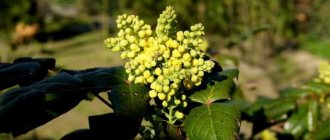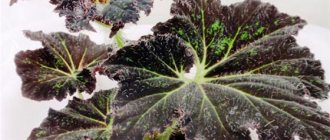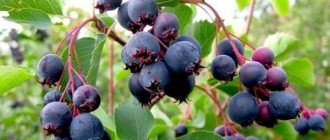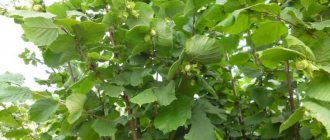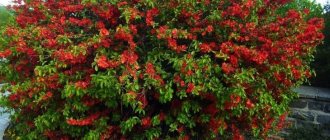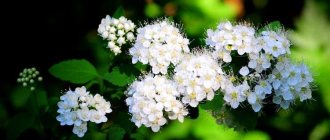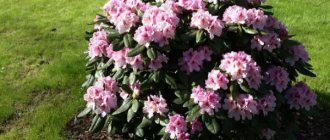The evergreen mahonia plant, known since 1818 as the "Oregon grape" or lat. "Mahonia" belongs to the Barberry family. An ornamental shrub with black and blue berries, which have beneficial properties and an unusual taste, does not require special maintenance conditions or soil fertilization. It tolerates frost and arid climates well and grows in the shade. A tree up to 1.5 meters tall is widely used in landscape design.
What does Holly mahonia look like?
Mahonia holly belongs to the Barberry family - these are dicotyledonous flowering plants that are included in the order Ranunculaceae. They include more than 40 species that are common in America and Asia. Such popular varieties as Apollo and Atropurpurea were bred by Dutch gardeners in the 20th century.
Appearance
Description of appearance: the mahonia plant looks like a thornless shrub with shiny alternate leaves. The small flowers are yellow in color and are located in large inflorescences. The leaves are framed along the edges with teeth. The fruits are blue. It is rare to find a mahonia bush with red or white berries. The shrub grows up to 1.5 meters. The leaves turn reddish-bronze in autumn.
Features of the Mahonia shrub
Mahonia is an evergreen shrub, reaching a height of about 100 centimeters. It has abundant root growth. On old stems the bark is brownish-gray, and on young stems it is grayish-pink. The odd-pinnate compound leaf blades have light red petioles and consist of 5–9 sharp-toothed, notched leaves, which reach 15–25 millimeters in width and 3–9 centimeters in length. These leaves are dark green, leathery, their front surface is shiny and the back surface is matte. Multi-flowered axillary racemose or paniculate inflorescences consist of bright flowers of a pale yellow color (sometimes found with a lemon tint), the diameter of which can reach 0.8 cm. The fruits are oblong-elliptical berries, painted black and blue, with a a thick coating of bluish-colored plaque, as well as a cannon. These berries reach 1 cm in length and 0.8 cm in width; they have a rather pleasant sweet and sour taste and are used in confectionery production, and they are also used to color wines. Flowering occurs in April and May, while the berries ripen in September or August.
In landscape design, this plant is used to create borders, low hedges, group plantings, it is also planted solo or used for lining tall shrubs. In winter, the shiny leaf blades change their color to green with a beautiful red tint. Also, this shrub looks very impressive during the ripening of purple-blue berries covered with a waxy coating.
Shrubs for the garden. Mahonia holly. Website "Garden World"
What types of mahonias are there?
Gooseberry Kolobok - secrets of growing shrubs
Mahonia is crossed with plants from the barberry genus. Among the popular decorative forms are the following:
- Nutifolia (f. juglandifolia). Looks like mahonia holly. The difference is in the foliage. The plant has 7 small leaves on each branch. The leaves are dense with red petioles.
- Graceful (f. gracilis). Differs from the typical species in having longer leaves.
- Golden (f. aurea). The foliage of this mahonia has a golden color.
- Variegated (f. variegata). The leaves contain a heterogeneous color consisting of green and gold spots.
Additional Information! Caring for the above decorative species is no different from caring for ordinary mahonia.
Use in the garden
Plants such as mahonia are grown more for decorative purposes than for their harvest. The unusual structure of the leaves, large caps of inflorescences, bright clusters of berries - all this distinguishes the shrub from other plants. In European countries it is often used for landscaping parks and residential areas. In the garden it looks great both solo and in various combinations. In the garden, its use can be as follows:
- Hedge, border.
- Decoration of lawn, flower beds.
- Addition to the group of flowering plantings.
- Framing of decorative stones.
- Background planting to fill empty space.
If the garden plot is located close to the slopes, it is good to plant these places with mahonia to protect them from shedding. The plant is firmly anchored in the ground thanks to its branching roots, and at the same time it will decorate the area and decorative fencing. Shrubs can also be used to dilute low-growing plantings and be used in the lower tier in combination with tall trees. The unpretentiousness of the plant is a big plus, making it much easier to care for your summer cottage.
To make a living fence using mahonia, it is enough to plant several seedlings in a straight line. After some time, the bushes will independently grow into a real hedge, in which there will be no gap. The young growth that forms on the roots prevents weeds from multiplying, which saves time on weeding.
The foliage of the plant does not fall all year round, which makes it possible to use it for framing decorative stones. The ability of the root system to grow widely is used to fill empty spaces around the composition. By pruning branches, you can ensure that the bushes change their shape in the desired way, emphasizing the beauty of other plants. Mahonia perfectly complements alpine slides. While other plants wither and wither for the winter, Oregon grape fills the void with its lush foliage, preventing the arrangement from looking dull and neglected.
The bush can be used to decorate a winter garden. It grows well in gravelly soil. An evergreen plant will decorate the area with its foliage regardless of the time of year. The exotic appearance of mahonia will add exoticism to the garden. A big plus of the plant is its high adaptation to weather conditions. It tolerates both drought and cold well. This minimizes the effort required to care for it. The shrub is resistant to diseases and is not affected by various garden pests.
Mahonia goes well with conifers. Dense foliage fills the empty space well, and the yellow inflorescences and blue fruits contrast well with the green needles. Low, dense growth of Oregon grapes around the rose garden is a wonderful arrangement for single or bushy decorative flowers. This plant combines well with other flowering shrubs. It looks harmonious with the following plants:
- magnolia grandiflora;
- Camellia tree;
- rhododendron;
- mock orange;
- action.
In addition to its decorative function, mahonia also plays a useful role in the garden. She is not afraid of insects that attack the fruit-bearing trees we are accustomed to. The plant is planted between fruit and berry plantings (apple tree, cherry, currant, gooseberry) to protect them from insects. During flowering, the sweet aroma emanating from the buds attracts bees and bugs, which pollinate the flowers.
Types of mahonia holly found in nature
Gooseberry Ural emerald - features and characteristics of the bush
Some varieties of mahonia have their own characteristics of cultivation and care. Below are some of the most famous species in gardening.
Creeping Mahonia (Mahonia repens)
The shrub varies in height from 20 to 50 cm. The leaves are large green. Blooms from late spring to early autumn. The fruits ripen towards the end of the summer season. The mahonia flower has a lemon color. The plant survives even with sudden temperature changes.
Creeping
Japanese Mahonia (Mahonia japonica)
Widely distributed in Japan and other tropical regions. The aroma is reminiscent of lily of the valley flowers. The shrub grows up to 150 cm. The inflorescences are directed in different directions. The flowers have a bright yellow tint.
Japanese
Mahonia Winter sun
The plant reaches 200 cm in height. Blooms in winter. In appearance it resembles Japanese.
Winter sun
Mahonia Fremontii
The shrub grows up to 300 cm. The young plant has gray-blue leaves. The berries are red.
Fremonti
Mahonia eurybracteata Soft Caress
The plant comes from China. The leaves are narrow. Flowering occurs in summer. The bush is grown in special containers and in greenhouses.
Software
Mahonia Neubertii
The height of the plant does not exceed 110 cm. The leaves are ovoid in shape.
Newbert
Additional Information! The listed species are artificially bred hybrids of barberry with other varieties of mahonia.
Application
Mahonia berries are used for culinary and medicinal purposes. They find this use due to their natural composition, which determines their medicinal properties. Useful elements are found equally in the pulp and skin. In cooking, fruits are used mainly heat-treated. They are made from:
- jam
- compotes, fruit drinks
- jams
- tinctures
- pie filling
Fresh berries have a pleasant sweet and sour taste. Its juice is added to ice cream and dessert creams. Some people like to eat it by grinding it with sugar. However, not everyone likes its slightly astringent taste. Muesli is made from dried fruits. Decoctions of dried berries are drunk for blood diseases and intestinal dysfunction. Hot drinks also help with colds and weakened immunity. Medicinal infusions can be made not only from the fruits, but also from the bark and flowers of the plant. Compresses made from these compositions are used to treat skin pathologies.
Varieties most popular among gardeners
Rose Pomponella - characteristics of the varietal shrub
The varieties presented below are winter-hardy and unpretentious in care, which attracts the attention of gardeners.
- Mahonia Apollo. The bush grows from 50 to 100 cm. The leaves are 25 cm long, have a sharp-toothed edge and consist of 7 leaf plates. In summer they are green, and in autumn they turn brown. The flowers are lemon-colored. Dark blue berries contain a waxy coating on the skin.
- Mahonia atropurpurea (Autropurpurea). The height of the bush reaches 65 cm. The leaves are dark green. They do not exceed 30 cm in length. The flowers are bright yellow.
- Mahonia Smaragd. A distinctive feature is shiny emerald-colored leaves with a clear pattern of veins.
Types for the middle zone
The following varieties of mahonia are popular in our area:
- Holly-leaved: a bush reaching one and a half meters wide and one meter long. It is distinguished by its prolific root layering.
- Creeping: creeping shrub growing up to 45 centimeters. Used to cover the soil and design decorative rocky gardens.
- Japanese: reaches two meters in height, three meters in width. The length of the leaf plate is up to 30 centimeters. Has reddish cuttings.
The most common of these species in Russia is Mahonia holly. It is valued for its fruits. Resistant to low temperatures, can withstand frosts down to -30°C.
How does Magonia holly propagate?
Mahonia is cross-pollinated. A single bush has no harvest. If a gardener grows shrubs as an ornamental and berry crop, then he needs to plant at least 2 plants nearby. There are several ways to propagate mahonia.
Cuttings
To propagate mahonia holly by cuttings, it is necessary to cut branches with 6 buds in early spring. They are planted in the shade. The soil is moistened daily. Before the first winter, the cuttings are hilled up and covered with straw. Next season they will be planted in a permanent place.
Cuttings
Dividing the bush
At the beginning of spring, when the sap has not yet begun to move in the trunk and branches, the bush is divided into several shoots. The cuttings are planted in a permanent place in the usual way.
By layering
In spring, one of the branches of the plant is lowered to the ground and secured with a metal bracket. The leaves are first removed, and the lowered stem is sprinkled with earth. No additional care required. In the spring, the seedling that was successfully grown is transplanted to a new location.
Growing from seeds
This is a labor-intensive method. In autumn, seeds are sown in holes 2 cm deep. They can also be planted in spring after stratification at temperatures from 0 to +5 degrees. The seedlings are left in the shade. In the fall it is thinned out and planted in separate boxes. After 1.5 years, the seedlings are planted in open ground. Mahonia will begin to reproduce by layering after 4 years.
Important! Some gardeners, when propagating a bush from cuttings, cover the branches with plastic bottles. There is no need to do this. Roots will appear without additional intervention.
Properties of mahonia - harm and benefit
Benefit
Mahonia fruits contain a lot of ascorbic acid, which helps strengthen the immune system. If you simply eat these fruits, you can strengthen the walls of blood vessels, improve lymph flow and speed up blood circulation. Mahonia also contains tannins, various types of alkaloids and organic acids.
The fruits also contain berberine, which helps protect the bone marrow and helps the body quickly recover after a course of radiation and chemotherapy. Scientists from Australia have found that berberine can increase insulin activity; therefore, it began to be used during the treatment of complex forms of diabetes.
An extract from the roots of this plant stimulates the choleretic function of the body, so it is used for gastritis, hepatocholecystitis, hepatitis, inflammation and blockage of the biliary tract and giardiasis. It is also used to eliminate edema, during the treatment of acne, eczema and herpes, and is also used to normalize the functioning of the gastrointestinal tract and restore intestinal microflora. The hood also has an antibacterial and antiviral effect.
The bark of Mahonia holly contains substances that are used in the treatment of psoriasis.
Contraindications
Mahonia products should not be used during pregnancy and breastfeeding, or by persons with individual intolerance to such a plant. Also, people with chronic intestinal disorders, ulcers and high acidity of gastric juice should not use such products. The use of such drugs in some people can cause diarrhea and nausea, therefore, before eating mahonia fruits or using products prepared on its basis, you should definitely consult with a qualified specialist.
ANTI-CANCER PROPERTIES OF MAGONIA AND COMPLETE FREEDOM
Features of garden care
Caring for and growing mahonia holly includes daily watering, fertilizing, treating the bush from pests, and pruning. The plant needs a lot of moisture; gardeners water the tree trunk and irrigate the upper branches. This should be done in the evening. Mature shrubs do not need to be watered unless the weather is dry. In hot summers, plants should be irrigated 2 times every 14 days.
Care
Shrubs are fed twice in 12 months: the first in May, and the second at the end of February. Mineral complexes are used as it. 150 g of fertilizer is required per square meter. When preparing shrubs in open ground for winter, the soil is sprinkled with compost or humus. Their layer must be at least 6 cm.
It will not be possible to care for mahonia without replanting. It is carried out throughout the growing season. The bush should not be replanted only in the fall. It will not have time to take root and will die with the onset of cold weather. Care also includes pruning diseased, dry and frozen branches during the winter. It is done at the end of February. To prevent the bushes from being thinned out and to remain low, pruning is done in October after the plant stops blooming.
Young bushes are covered with spruce branches before winter. Adult shrubs should be subjected to the same manipulations only if frost is predicted. The plant survives calmly under the snow. Mahonia prefers loose, fertile soil. The best option for it is soil consisting of humus, sand and turf soil.
Important! After heavy rain, the soil around the tree trunk is loosened.
Proper wintering in the Moscow region and other regions
Mahonia tolerates low temperatures well. Only young bushes that were planted one or two years ago need to be prepared for wintering. This happens as follows:
- In October, the root system is earthed up. The neck and trunk circle are covered with earth (the higher it is, the better).
- Mulch with straw, sawdust, hay. The base of the bush is covered with spruce branches. This will help prevent the rhizome from freezing.
- Mahonia branches are protected by covering them with snow. This is not necessary, but it helps a lot in cold weather.
Mulch and spruce branches are removed as soon as the snow melts. This is necessary to warm the earth. The soil around the plant is leveled.
When and how does it bloom
Flowering lasts from April to May. Mahonia belongs to the order of dicotyledonous flowering plants. This is a class in which the flower acts as a reproductive organ, and the seed embryo has two cotyledons located on the sides. The flowers consist of 9 sepals and 6 lemon-colored petals, collected in paniculate inflorescences. The leaves are arranged in two circles.
Flowers
The anthers open in a folding manner, from bottom to top. Between the sepals and stamens in some varieties there are two circles of nectaries. The superior ovary is one and consists of one carpel. The ovules are numerous, in some varieties solitary, located along the ventral suture of the ovary.
The fruits are blue berries. They reach 1 cm in length and 0.7 cm in width. There is a small fluff on top of the berries. One fruit contains 2-8 seeds.
Berries
Types and varieties
There are about 50 unique specimens of a small ornamental shrub.
For example, mahonia aquifolium (lat. mahonia aquifolium) is a perennial evergreen plant of the Barberry family. The shrub has acclimatized to the warm, changeable weather of America. The gray bark contains sapwood inside, bright yellow wood with growth rings. The leaves with a spiky, jagged edge have a complex structure and stipules can form. During flowering they turn green to olive green. During the ripening period, the fruits turn dark green. In autumn and winter they acquire red-golden or bronze tones, and then change color to dark brown.
mahonia holly
The optimal height of a deciduous shrub is only 1.5 meters. The low-growing plant is decorated with multiple branched shoots. Yellow inflorescences, reminiscent of lush panicles, appear in the middle zone closer to the beginning of May. The flowers have 6 petals and the same number of stamens, arranged in two circles. Re-blooming is possible in October, during the hot “Indian summer”. After 3-4 years the tree begins to bear fruit. Blue-black or gray berries within 8 mm ripen in September. They have a sweet taste with a distinct sourness.
If you are breeding mahonia holly in the northern latitudes of Russia, you must take care in advance to cover the young seedlings for the winter.
The ideal material is dry foliage or spruce branches.
mahonia holly
In the southern regions of Japan and China, Japanese mahonia or lat. Mahonia japonica. It is a representative of the Buttercup order, the Barberry family. The evergreen tree was cultivated in Asia and gradually spread to Europe and the USA. Large dimensions up to 4 meters make it possible for single and group planting. Weakly branching shoots allow the plant to be used in decorative landscaping of personal plots.
The bark is covered with cracks, equipped with a cork layer, and has a gray tint. Young wood retains a bluish color. The apical buds with elongated dark green and oval scales reach 5 cm. Dense elastic leaves 30-45 cm long have the shape of an arc, bent downwards. During the ripening period, the fruits change color to red-purple.
Flowering in May-June is accompanied by the appearance of pale yellow petals, which are collected in buds with a diameter of 6 mm, and a pleasant aroma reminiscent of lily of the valley. With the arrival of September, blue oblong berries with a matte surface are visualized. The fruits are small, up to 8 mm in volume.
Japanese mahonia
Mahonia holly "Apollo" was bred by Dutch scientists in 1973. Received the name Mahonia aquifolium Apollo. The barberry shrub is a slow-growing evergreen garden crop. Forms an ideal ground cover due to its compact crown. Requires moisture maintenance, loves humus-rich soil and sunlight. During the dry season, watering can be done twice a week. For one bush, 10 liters of water is enough.
Despite the fact that the plant reaches only 0.6 meters, this disadvantage is compensated by intense flowering in May. You can enjoy the fragrant chocolate aroma of numerous yellow flowers for more than 25-30 days. The rich green leaves, 30 cm long, take on a bronze color at the end of August and turn red-brown in autumn. Sweet and sour berries ripen in early August. Dark blue fruits can be up to 1 cm in size. To protect the tree from frost, it should be covered during the first winters.
Mahonia holly "Apollo"
Mahonia media "Charity" or Mahonia media "Charity" is an upright shrub that reaches a height of 1.5 meters. An adult plant has an oval crown with a diameter of 60 cm and numerous shoots. The hard oval leaves are equipped with sharp teeth along the edges. Shiny and green in the summer, they turn burgundy by autumn. The yellow flowers, which appear in May, are collected in apical spikes. Already at the end of summer the tree bears fruit with blue-black berries. Like all specimens of mahonia, they acquire a bluish tint. The advantage of planting "Charity" is its unpretentiousness. Prefers partial shade and does not require additional soil fertilization. To be on the safe side, with the onset of cold weather you can insulate the bush.
Mahonia media 'Charity'. Oregon grape
Mahonia repens is known from Canada to New Mexico, California and the northern United States. But the creeping shrub 50 cm tall has not gained wide popularity. Blue-green matte leaves of a round shape have teeth along the edge, united in 3-7 pieces. Flower clusters appear in May, and fruits in September. Black berries with a distinct fluff taste sweetish and sour. Thanks to root growth, the plant acquired the status of a bush. The following types of creeping mahonia are used for decorative purposes:
- round-leaved. The shoots consist of 5 separate leaves;
- large-fruited. The size is 1.5 times larger than traditional berries. They are classified as poisonous and dangerous.
Frosts do not affect the plant. Easy to care for. Transplantation does not depend on the age of the bush. You should avoid replacing the soil only in late autumn. If you plant an evergreen tree in dense groups, you must maintain a distance of 1 meter. Particular attention should be paid to the soil. We must not forget the proportions of humus, turf soil and sand, maintain a ratio of 2:1:1. It is necessary to feed in early spring and before flowering. The soil must be constantly loosened, since the low-growing species does not like compaction. In clayey areas, it is better to provide drainage, the layer of which should be about 20-25 cm.
For planting, it is better to choose a well-lit place or partial shade. Otherwise, the growth rate and overall appearance of the landscape will slow down.
In order to pollinate mahonia, it is recommended to place several bushes nearby. This will help speed up the cross-transfer of pollen in the plant and increase the volume of future fruits. If there is no need for berries, this rule can be circumvented. The stimulator for intensive growth and lush forms is sunlight and humus soil. When designing and creating a natural design in a city or an elite suburban area, the shoots are shortened and the crown is trimmed.
Possible problems in growing
Mahonia is resistant to pests and various diseases. However, if not properly cared for, the plant will show signs of rust, powdery mildew, and spotting. Below is a list of diseases, as well as recommendations for their treatment.
- Spotting. It appears in the form of purple spots of different sizes located on the leaves of the plant. They can form if the plant is planted in an area with polluted air and due to a lack of nutrients. Spotting is treated by spraying with products containing copper or polycarbacin.
- Powdery mildew. This is a fungal disease that affects the leaves and fruits of the bush. It looks like a white spotty plaque. Treat the bush in the summer, spraying it with Topsin-M or Karatan once every 2 weeks. As a preventive measure, shrubs are fertilized with mixtures that contain large amounts of potassium and phosphorus.
- Rust. The disease is caused by a rust fungus. It looks like orange spots on the leaves. Soon these pustules fall off. When you touch them, rusty sand remains on your hands - fungal spores. Rust reduces frost resistance and impairs yield. Its development is promoted by excess amounts of nitrogen fertilizers. Cinabom and products containing sulfur help get rid of rust.
- Phyllosticosis. This disease is a spreading infection. The affected areas become brown or brown in color. The leaves die over time, and the intensity of flowering deteriorates. The disease is spread by wind and raindrops. The fungus gradually begins to penetrate the stem, as well as the root system of the plant. To get rid of it, you must first remove the affected and fallen leaves, and then treat the bush with a fungicide.
Disease
The main indicators that the gardener is not properly caring for the bush are the formation of spots, as well as other lesions, excessive falling of fruits, leaves and buds. If the plant begins to wither, then it must be transplanted to a new place, cut off all damaged areas, water, and then add fertilizer to the soil. If necessary, the bush is sprayed with a “medicinal” agent.
Among pests, mahonia, like barberry, attracts the attention of the following individuals:
- Aphid. It is a small insect with a yellow or red color that lives under the leaves of the plant. The aphid is slowly eating the bush. “Aliot” or “Kinmiks” will not help you get rid of it. You can also make the product yourself by mixing a spoonful of tobacco, soap and 200 ml of water.
- Sawfly. It looks like a caterpillar with a black head and sixteen legs. The insect feeds on shoots and leaves. The drug “DNOC” will help get rid of it.
- Codling moth. This insect eats the fruits of mahonia and other trees in the garden. It is a gray-brown moth larva that leaves its offspring inside foliage or fruit. The hatched insects begin to rapidly eat the plant. They get rid of it with the help of insecticides.
In order for all the products to be as effective as possible, before spraying, all affected leaves are cut off and burned. Irrigate the bush before the buds appear.
Important! The procedure is repeated without fail after 20 days.
Growing and care
Mahonia holly is decorative and easy to grow. She just doesn’t like replanting because she has a weak root system.
The bush is resistant to air pollution.
Watering
This shrub has green leaves all year round. Thanks to this, mahonias are ideal for all types of autumn and winter decorations and wreaths. However, this has some implications for cultivation. The plant needs water all year round. Since the leaves evaporate water in winter, the bush should be watered whenever the weather permits (when the winter is dry but there is no frost). Before winter, the plant should be watered abundantly. It is also worth watering the bushes quite generously in the fall.
In summer, during drought, you must not forget to water mahonia, especially if it is grown in a container. Also, container plants are watered during the winter in a bright room protected from frost.
Watering Mahonia is necessary systematically, but moderately. Overall the plant is very hardy. Only with a lack of water do the leaves partially or completely dry out. It is enough to water moderately once every 1-2 weeks, depending on the weather (more often in dry weather) and mulch. Dark green glossy leaves are a sign that the shrub has excellent conditions in the garden.
Fertilizer
Mahonia does not have high requirements for fertilizers. For fertilizing, 1-2 doses of fertilizer for flowering plants are enough according to the dose on the package with an interval of 2-3 weeks. More doses can be used if the soil is very weak and sandy.
In the spring, you can apply multi-component fertilizers or a little granular manure, in the fall - fertilizers containing phosphorus and potassium (these elements help plants survive the winter).
It is important not to feed mahonia with calcium fertilizers; these rather acid-loving plants do not tolerate calcium well.
If the bush grows under fruit trees, instead of mineral fertilizers, you can use organic fertilizers - nettle infusion or diluted manure fertilizer.
Trimming
Theoretically, mahonia does not need to be pruned. But in order for the bush to have a beautiful shape and be dense, it is worth pruning.
After flowering, prune the mahonia, shortening the faded shoots by 1/3 of their length. Pruning of mahonia holly is carried out in April-June. The plant tolerates pruning well, even hard pruning.
However, it is better to limit yourself to correcting the shape of the bush and sanitary pruning. After winter, dried and broken shoots must be removed. If you prune your mahonia too much, it will bloom less well and bear less fruit. It is advisable to trim it regularly every year, but not very intensively. This makes the bush dense and produces more flowers.
If the bush is not pruned regularly, it will drop its lower leaves on its own. If this happens, the plant needs to be cut back to the base of the strongest shoots, about 30 cm above the ground.
Attention! Mahonia leaves are prickly, hands must be protected when caring for the plant.
Care in autumn, wintering
Mahonia tolerates mild winters, but is planted in very secluded places, protected from the wind, preferably with high air humidity. In cold climates, this species can be grown in a container, which is placed in a cool and bright room in winter (optimal temperature is around 0 °C).
Before frost sets in, water the bushes generously and mulch the ground around with a layer of bark about 5 cm thick. If the shoots dry out in winter (especially on light soils), they quickly grow back after pruning.
The frost resistance of holly-leaved mahonia is higher than that of other species. In winter, the plant often dries out. This is not the result of freezing, but of drying out. Therefore, it is worth mulching the soil. Mulch prevents the soil from drying out even in winter. In the Moscow region and Central Russia, gardeners recommend tying branches with string and covering the plant with non-woven material. You don’t have to cover it, but bend it to the ground so that the plants are covered with snow.
If the plant dries out in winter
If mahonia dries out in winter, it is a sign that the soil has run out of available water. This happens when winter is frosty and there is no snow. Holly-leaved Mahonia is frost-resistant. In winter, it draws water from the ground, but this process is slower than during the growing season. Due to the fact that it has a shallow root system and a large mass of leaves, when the ground freezes and there is no snow, it cannot absorb water. As a result, mahonia dries out in winter, although it is resistant to severe frosts.
Symptoms of winter drought:
- partially or completely dried leaves;
- dried young twigs;
- curled leaves;
- drying out of whole plants - in extreme cases;
- young leaves are most susceptible to drying out in winter; the first symptoms are their twisting.
Attention! Symptoms caused by winter drying usually appear on Mahonia only in January - March.
The plant is most susceptible to winter drought when it is growing:
- On light sandy soil.
- Under a tall tree.
- In an area where dry, frosty winds often blow in winter.
Ways to prevent mahonia from drying out in winter:
- Mulching - bark, cones, wood chips are suitable. The litter protects the soil from deep freezing and evaporation of water; it should be at least 3-4 cm thick. Mahonias, especially young ones, should have litter all year round, not only in winter. The bushes are also susceptible to drying out in the summer heat.
- Watering – Mahonia needs to be watered in the fall, before the ground freezes. It is also worth watering during the thaw in winter, especially when the winter is snowless. However, do not overdo it with the amount of water. Excess water can cause root rot.
- If the bush dries out in winter, it does not need to be covered with pine branches or agrotextiles. Just mulch and water.
Diseases and pests
Mahonia is resistant to various pathogens and pests, and practically does not get sick. But on heavy soils and excessive watering it can be affected by fungal diseases. In the USA it has become very popular because it is not eaten by deer and rabbits (they often ruin gardens there). If the leaves of a plant dry out, this is most often a sign of a lack of water in the soil.
Use in landscape design
Mahonia is one of the ornamental plants. Its fruits and flowers have a bright color that fits perfectly into the landscape design. Often, shrubs are planted to create a decorative forest belt. The average number of rows of bushes in it is 3-5. Despite the fact that such a forest belt is necessary only for a beautiful view, it also performs practical functions. Rows of mahonia bushes provide protection from the wind and keep out noise.
Single bushes among the lawn look interesting, but such plants require additional care. Over time, their root collar begins to rot, which leads to death. To avoid such a situation, a well is formed around the trunk. It is designed in the form of a small fence or bench. The bush is dug around to create a slope.
Design
Mahonia is used to create a hedge. To control the growth of its root system, slate or metal plates are dug into the sides of the fence at the stage of planting. To create the desired contour, after flowering is completed, excess branches are trimmed. Trimming is also done in the spring to get rid of frozen branches. In case of severe frosts, burlap is thrown over the fence. In addition, landscape designers create beautiful combinations of shrubs with low-growing trees, bulbous flowers and roses.
Mahonia contains many tannins, ascorbic acid and alkaloids. The use of its extract in medicine allows you to fight diseases of the vascular system, intestinal tract, as well as low blood sugar. With proper care, the shrub may not wither for many years. After pruning, the plant recovers quickly. Mahonia is easy to care for and tolerant of temperature changes.
Pests and diseases
The plant is rarely affected by insects and diseases. Sometimes the following appear on mahonia:
- Powdery mildew. White spots appear on the upper part of the leaf blade, which eventually spread to the entire above-ground part. If you examine the plant more carefully, you can see cobwebs and lumps of cotton wool. Powdery mildew spoils the appearance of mahonia, but does not lead to its death. You can get rid of the disease by spraying with Fundazol, Topsin-M, Karatan. Manipulation is performed once a day for 10-12 days.
- Rust. Pustules of different sizes and shapes form. When the formations are damaged, a “rusty” powder with fungal spores appears from them. Fungicide solutions help against pathology: Tsineb, Abiga-Pik, Bayleton, Oksikhom.
- Phyllosticosis is a fungal infection that causes the formation of large spots on the foliage. Pycnidia appear at the top of the plaques. During the season, the fungus produces several generations. The plant loses its decorative appearance. The leaves fall prematurely. Flowering and fruiting deteriorate. To get rid of them in the spring, the affected leaves are collected and destroyed. Mahonia itself is treated with Oxychom, Captan or Fthalan before sap flow begins.
- Stagonosporosis. It is characterized by the appearance of oval spots with a border along the edges of the leaf blades. Round pycnidia are formed on top of them. Mahonia withers and dies. Treatment is the same as for phyllostictosis.
Recommendations for planting shrubs
To avoid injury to the shrub, it is necessary to plant the plant in the spring, before the first buds begin to swell.
Mahonia can be transplanted at any age, but always in the warm season.
The main points in planting in open ground, and the nuances in caring for mahonia:
Preparation of the hole. The recommended length is up to 60 cm, and the width should be approximately 3 times the volume of the roots. A solution of humus, soil and sand mass is placed at the bottom of the hole.
Create drainage in open ground in the form of crushed stone or crushed stone, about 10 cm high.
The shrub is placed in a vertical position, the rhizome is straightened, and the lower part is covered with soil. Next, the soil is further compacted for plant stability;
Level the height of the soil around the bush with the height of the surrounding soil.
When growing a plant on the site, regularly loosen the soil and prevent cracks from appearing.
By following simple rules for planting and caring for the plant, you will ensure a long life for the shrub.
Preparing for winter
With good snow cover, mahonia overwinters well even without shelter, but under a dense layer of mulch. However, in regions where frosts of -30C and below are quite expected, this may not be enough, especially with low snow. To cover a low young bush, you can throw spruce branches and lightly sprinkle peat soil on top; tall bushes need to be carefully tied and tied, without tightening, with non-woven covering material. The older the bush, the easier it will survive the harsh winter. In the spring, you should not delay removing the cover to avoid overheating of the branches.
Fruit
The plant is cross-pollinated. If the gardener’s goal is not only aesthetic, then to pick berries it is necessary to plant two or more mahonia bushes. And although many do not consider the shrub a berry crop, with proper pollination it will be covered with fruits. From which they make excellent jam, filling for pastries and desserts, and the berries are also used as a coloring for wine drinks and compotes. Allergy sufferers use the berries as fabric dye.
The root of the plant is used in homeopathy. The healing extract from it is rich in tannins and vitamin C, increases the protective properties of the body. American residents of California have been using the extract for many centuries.
